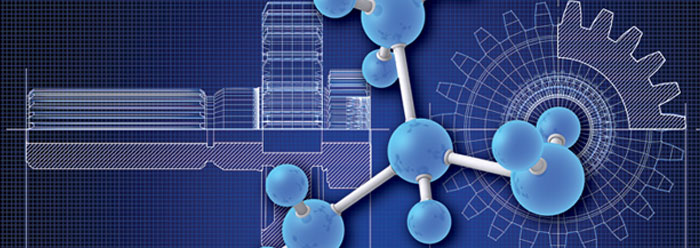Humans love machines. Everyone likes how they save time and make jobs easier. If a new machine is invented that helps detect specific diseases and aids in early diagnosis, it is big news.
People also enjoyed watching machines operate before their many moving parts were covered up for safety reasons. Now, TV programs that slice machines apart so people can look inside are popular. So it is likely that someone would listen intently if a Christian were to describe some real microscopic machines right inside their own bodies working to keep them alive.
Be assured that helping anybody learn of these intricate, minute machines will be a powerful testimony of the Lord Jesus' "invisible" qualities, like His endless power and intellect, that are clearly seen by the things He has made (Romans 1:20.)
Cellular Life Operates with Machines
Begin by showing that cellular machines, like man-made machines, consist of numerous interconnected moving parts that function together for an intended purpose--but are far superior. Functioning in repetitive mechanical cycles, cellular machines have chemical molecule "parts" that usually switch between two different--but still very precise--shapes in a strictly controlled manner. Like any motor, they convert fuel into kinetic energy to make things move in specific directions. A few examples are:
- DNA maintenance robots that proofread information, unwind the double helix, cut out defects, splice in corrections, and rewind the strands
- Intracellular elevators
- Mobile brace-builders that construct distinct internal tubular supports
- Spinning generators that move molecules from low to high energy states
- Ratchet devices that convert random molecular forces to linear motion
- Motors that whirl hair-like structures like an outboard motor
- A microscopic railroad with engines and tracks
Finally, describe how the machines are made to reinforce awareness of the total design process. Ask your acquaintance to visualize an assembly plant that is so advanced and so small that dozens could fit on the head of a pin. The energy to run both the assembly plants and machines is finely tunable and supplied by sunlight, molecular motions, heat, electricity, or chemical conversions.
Machine parts themselves are complex molecules corresponding to switches, batteries, motors, brakes, shafts, rods, hooks, bearings, bushings, springs, end caps, valves, seals, plugs, rivets, spot-welded joints, mounts, and braces. These are fitted together by other molecules that act like templates, work benches, clamps, and vises. Yet other molecules take the final products where they are trimmed, folded, and set to be activated. Another molecular work station will package, label, and transport products to their correct destinations. After the machine's useful life is ended, another apparatus will engulf it, break it down, and send the components back for recycling.
Molecular Machines Are Best Explained by Design
The microscopic size of these machines is vital to systematically fine-tune dozens of molecular properties. For example, many molecular motors must work cooperatively to transform molecular movements to visually detectable levels. All of these features are detailed in advance and the information is stored in the DNA's plans and specifications.
In a typical kitchen, there are food processors, blenders, and mixers. In some ways they look similar, but their capabilities actually have little overlap. Each machine has a primary function which it performs well based on the speed and manner in which its parts interact. These parts fit tightly together, which means that though a few blender and mixer parts have exactly the same function, one cannot just swap them. In similar manner, the parts of molecular machines are meticulously fitted together for their primary purpose. Many function in totally unique roles that are critical for life. And some cannot lose a single part or exchange parts with other machines without that machine--and the entire organism--breaking down.
In most people's minds, the words "machine" and "designed" belong together, so just knowing that complex cellular machines exist is sufficient evidence to make that connection. But others are stuck in evolutionary explanations for the origination of molecular machines. It would be beneficial to know why this thinking is better at rationalizing than explaining.
Evolutionists Submit Implausible Explanations
When looking at the evolutionist's best scientific journals for explanations specifically on the origins of molecular machines, stay alert for extraordinary extrapolations.1 For instance, if a window fan is the machine under investigation in one of these papers, be prepared to look for this predictable pattern:
Finding: Researchers discover that fans have electric motors that spin blades to move air.
Conclusion: Air conditioners are simple derivations of fans because they also have electric motors that spin blades--notwithstanding an air conditioner's unique motor, blades, compressor, condenser, evaporator, and thermostat.
The exaggeration is assured. Why? Since researchers find only one fully functioning machine or another, evolutionary conclusions of how, in the remote past, parts from one molecular machine morphed into another will always be conjectures inferred greatly beyond what the findings support.
These papers survive peer review still containing extraordinary extrapolations that sidestep real explanations for the arrival of fundamentally distinct parts, instead depicting molecular parts as (somehow) having been stripped from primary functions elsewhere in the cell and spontaneously re-assembled into new machines. Critics point out that those great gaps of information make the evolutionary path unbelievable. Note how these weaknesses are merely dismissed when a top evolutionary authority like Dr. Jerry Coyne says, "It is not valid, however, to assume that, because one man cannot imagine such pathways, they could not have existed."2 Be content in recognizing that those types of responses cannot be satisfied with scientific answers.
Lacking experimental evidence supporting their explanations about molecular machines, evolutionists have turned to a firm belief that if it can be imagined, it could happen. In conversation, highlight this disconnect. Point out that, given the extreme precision of these machines, evolutionary accounts must repeatedly use three words not normally associated with precision: "recruited,"3 "cobbled,"4 and "tinkered."5
Thus, evolutionists believe in a simplistic scenario where "the necessary pieces for one particular cellular machine...were lying around long ago. It was simply a matter of time before they came together into a more complex entity,"6 upon which natural selection tinkered away at cobbling together borrowed parts for millions of years. Aside from the magical whimsy, this explanation is like saying cars originated when an engine was coupled to a transmission, which was mounted to a chassis, and so forth. Leaving another major unanswered question--where did the engine, transmission, and chassis come from?
Learning a Short Example
Do evolutionists really recognize the intricacies of molecular machines yet attribute their origins to ill-defined forces? Princeton University researchers recently described a theory to explain how some cellular machines enable organisms to rapidly adapt to environmental stresses. The report detailed elaborate principles guiding cooperation between machines that was "analogous to a car's cruise control or a home's thermostat."
[Lead study author Raj] Chakrabarti said, "Control theory offers a direct explanation for an otherwise perplexing observation and indicates that evolution is operating according to principles that every engineer knows." The scientists do not know how the cellular machinery guiding this process may have originated, but they emphatically said it does not buttress the case for intelligent design, a controversial notion that posits the existence of a creator responsible for complexity in nature.7
An alternative explanation exists that actually fits with observed origins of every other machine. The information for the parts and construction of "cruise control"-style molecular machines was the result of real design with the intent of enabling organisms to diversify, multiply, and fill new environments.
Pulling It All Together
The best way to appreciate machines is to watch them. Unfortunately, pictures of molecular machines are rare and drawings most likely will not be available during spontaneous conversations. But using words to build mental pictures of these incredible miniature machines can be effective. Human minds powerfully connect machines to design. People know that while some animals may use tools, only humans build machines.
For that reason, a conversation could be very engaging since it may be the first disclosure to most people of the existence of these machines. Why? Because in evolution-based education, not all scientific findings are equally welcome and, thus, are subject to being selectively promoted. The above frenzied foot-stomping denial of the research's obvious implication shows that getting people to believe in evolution is a higher priority than learning.
Revealing this convoluted thinking that does attribute precise microscopic machines to blind tinkering--but not to design--will let it be seen for what it is. So, go ahead and tell someone about these life-sustaining little machines. They may build the bridge for someone to find eternal life in their life-giving Creator.
References
- See Clements, A. et al. 2009. The reducible complexity of a mitochondrial molecular machine. Proceedings of the National Academy of Sciences. 106 (37): 15791-15795.
- Coyne, J. A. 1996. God in the details. Nature. 383 (6597): 227-8.
- McLennan, D. 2008. The Concept of Co-option: Why Evolution Often Looks Miraculous. Evolution: Education and Outreach. 1 (3): 247-258.
- Hersh, B. and S. B. Carroll. 2005. Direct regulation of knot gene expression by Ultrabithorax and the evolution of cisregulatory elements in Drosophila. Development. 132: 1567-1577.
- Clements, 15793. Also Jacob, F. 1977. Evolution and tinkering. Science. 196 (4295): 1161-1166.
- Report on Clements' PNAS article (reference 1). Keim, B. More 'Evidence' of Intelligent Design Shot Down by Science. Wired Science. Posted on wired.com August 27, 2009, accessed June 5, 2010.
- MacPherson, K. Evolution's new wrinkle: Proteins with 'cruise control' provide new perspective. Princeton University news release, November 10, 2008, reporting on research published in Chakrabarti, R. et al. 2008. Mutagenic Evidence for the Optimal Control of Evolutionary Dynamics. Physical Review Letters. 100: 258103.
* Dr. Guliuzza is ICR's National Representative.
Cite this article: Guliuzza, R. 2010. Life's Indispensable Microscopic Machines. Acts & Facts. 39 (8): 10-11.






















